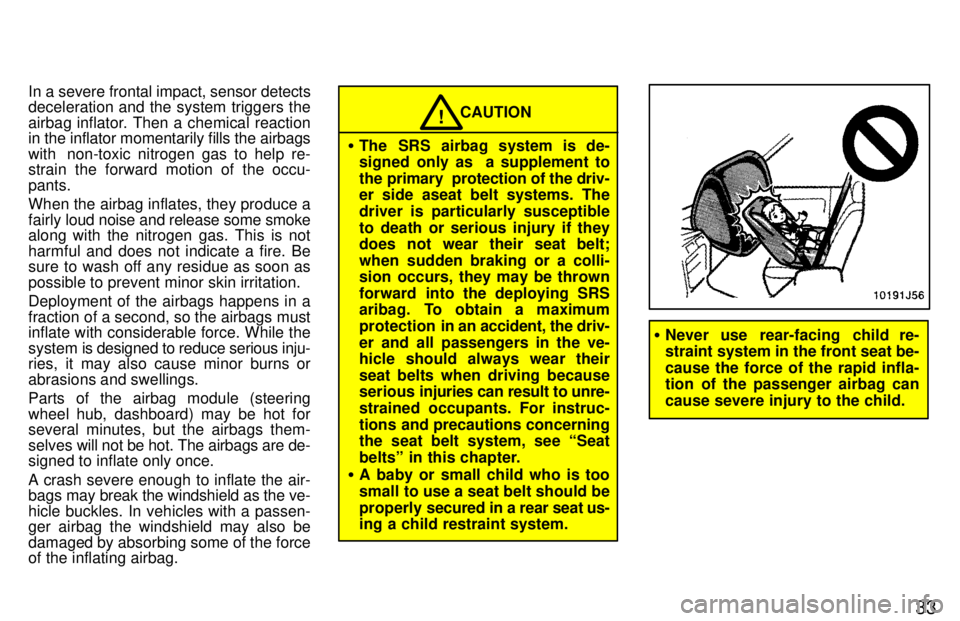sensor TOYOTA 4RUNNER 1997 Owners Manual
[x] Cancel search | Manufacturer: TOYOTA, Model Year: 1997, Model line: 4RUNNER, Model: TOYOTA 4RUNNER 1997Pages: 223, PDF Size: 4.66 MB
Page 27 of 223

31
The SRS (Supplemental Restraint Sys-
tem) airbags are designed to provide
further protection to the driver and
front passenger when added to the pri-
mary protection provided by the seatbelts.
In response to a severe frontal impact, the
SRS airbags work together with the seat
belt to help preventing or reduce injury by inflating, in order to decrease the likeli-
hood of the driver's or front passenger's
head or chest directly hitting the steering
wheel or dashboard. The passenger air-
bag is activated even with no passenger
in the front seat.This indicator comes on when the
ignition key is turned to the ACCº or
ONº position. It goes off after about 6
seconds. This means the SRS airbag
is operating properly.
The SRS airbag warning light system
monitors the airbag sensor assembly, in-
flators, warning light, interconnecting wir-
ing and power sources.The SRS airbag system is designed to
activate in response to a severe frontal
impact within the shaded area be-
tween the arrows in the illustration.
The SRS airbags will deploy if the severity
of the impact is above the designed
threshold level, comparable to an approxi-
mate 20 km/h (14 mph) collision when im-
pacting straight into a fixed barrier that
does not move or deform.
If the severity of the impact is below the
above threshold level, the SRS airbags
may not deploy.
SRS airbag
Page 28 of 223

32
However, this threshold velocity will be
considerably higher if the vehicle strikes
an object, such as a parked vehicle or sign
pole, which can move or deform on im-
pact, or if it is
involved in an underride col-
lision (e.g. a collision in which the noise of
the vehicle underridesº, or goes under, the bed of a truck). It is possible with collision severity at the marginal level of airbag sensor detection
and activation that only one of your ve-
hicle's two airbags will deploy. For your safety of all occupants, be sure to always wear seat belts.
The SRS airbags are not designed to inflate if the vehicle is subjected to a
side or rear impact, if it rolls over, or if
it is involved in a low-speed frontalcollision.The SRS airbag system mainly consists
of the following components and their
locations are shown in the illustration.
1 SRS airbag warning light.
2 Steering wheel pad (airbag and inflat- or)
3 Passenger airbag module (airbag and inflator)
4 Airbag sensor assembly.
The airbag sensor assembly consists of a
safing sensor and airbag sensor.
Page 29 of 223

33
In a severe frontal impact, sensor detects
deceleration and the system triggers the
airbag inflator. Then a chemical reaction
in the inflator momentarily fills the airbags
with non-toxic nitrogen gas to help re-
strain the forward motion of the occu- pants. When the airbag inflates, they produce a fairly
loud noise and release some smoke
along with the nitrogen gas. This is notharmful and does not indicate a fire. Be
sure to wash off any residue as soon as
possible to prevent minor skin irritation.
Deployment of the airbags happens in a
fraction of a second, so the airbags must
inflate with considerable force. While the
system is designed to reduce serious inju-
ries, it may also cause minor burns or
abrasions and swellings.
Parts of the airbag module (steering
wheel hub, dashboard) may be hot for several minutes, but the airbags them- selves w ill not be hot. The airbags are de-
signed to inflate only once.
A crash severe enough to inflate the air-
bags may break the windshield as the ve-
hicle buckles. In vehicles with a passen-ger airbag the windshield may also be
damaged by absorbing some of the force
of the inflating airbag.
CAUTION!
� The SRS airbag system is de-
signed only as a supplement to
the primary protection of the driv-
er side aseat belt systems. The
driver is particularly susceptible
to death or serious injury if they
does not wear their seat belt;
when sudden braking or a colli-
sion occurs, they may be thrown
forward into the deploying SRS
aribag. To obtain a maximum
protection in an accident, the driv-
er and all passengers in the ve-
hicle should always wear their
seat belts when driving because
serious injuries can result to unre-
strained occupants. For instruc-
tions and precautions concerning
the seat belt system, see Seat
beltsº in this chapter.
� A baby or small child who is too
small to use a seat belt should be
properly secured in a rear seat us-
ing a child restraint system.
� Never use rear-facing child re-
straint system in the front seat be- cause the force of the rapid infla-
tion of the passenger airbag can cause severe injury to the child.
Page 31 of 223

35
�Do not put objects on or in front of
the dashboard or steering wheel
pad that houses the airbag sys-
tem. They might restrict inflation
or cause personal injury as they
are projected rearward.
� Do not modify, remove or open
any component or wiring, such as
the steering wheel, column cover,
front passenger airbag, airbag
sensor assembly. Doing any of
these may cause sudden SRS air-
bag inflation or disable the sys-
tem, which could result in person-
al injury.
Failure to follow these instructions can result in severe injuries.
NOTICE
Do not perform any of the following changes without consulting your
Toyota dealer. Such changes caninterfere with proper operation ofthe SRS airbag system in some
cases.
�Installation of electronic itemssuch as a mobile two-way radio,
cassette tape player or compact
disc player
�Modification of the suspension system
�Modification of the front endstructure
�Attachment of a grille guard (bull
bar, kangaroo bar, etc.), snow-plow winches or any other equip-
ment to the front end
�Repairs made on or near the frontend structure, console, steering
column, steering wheel or dash-board near the front passengerairbag.
This SRS airbag system has a service re-
minder indicator to inf orm the driver of op-
erating problems. If either of the following
conditions occurs, this indicates a mal-
function of the airbags. Contact your To-
yota dealer as soon as possible to service
the vehicle. � The light does not come on when the
ignition key is turned to the ACCº or
ONº position, or remains on.
� The light comes on while driving.
Page 64 of 223

67
NOTICE
Do not continue driving if the engine drive belt is broken or loose.
(d) Low Oil Pressure Warning Light
This light warns that the engine oil pres-
sure is too low.
If it flickers or stays on while you are driv-
ing, pull off the road to a safe place and
stop the engine immediately. Call a Toyo-
ta dealer or qualified repair shop for assis- tance.
The light may occasionally flicker when
the engine is idling or it may come on brief-
ly after a hard stop. There is no cause for concern if it then goes out when the en-
gine is accelerated slightly.
The light may come on when the oil level
is extremely low. It is not designed to indi-cate low oil level, and the oil level must be checked using the level dipstick.
NOTICE
Do not drive the vehicle with the warning light onÐeven for one
block. It may ruin the engine.
(e) Malfunction Indicator Lamp
This lamp comes on in the following cases.
a. The fuel tank is completely empty. (See Fuel gaugeº in Chapter 1-5 for in- structions.)
b. The fuel tank cap is not tightened se-
curely. (See Fuel tank capº in Chapter
1-2 for instructions.)
c. There is a problem somewhere in your engine or automatic transmission
electrical system.
If it comes on while you are driving in case
c, have your vehicle checked/repaired by
your Toyota dealer as soon as possible.
(f) Low Fuel Level Warning Light
This light comes on when the fuel level in
the tank becomes nearly empty. Fill up the tank as soon as possible.
(g) ABSº Warning Light
This light warns that there is a problem
somewhere in your anti-lock brake sys-tem.
If the light comes on while you are driving,
have your vehicle checked by your T oyota
dealer as soon as possible. The light will come on when the ignition
key is turned to the ONº position. After
about 3 seconds, the light will go off. When the ABSº warning light is on (and
the brake system warning light is off), the brake system
operates conventionally but
anti-lock brake system is not assisting brake performance so that the wheels can
lock-up during sudden braking or braking
on slippery road surfaces.
(h) Open Door Warning Light
This light remains on until all the doors
and back door are completely closed.
(i) SRS Airbag Warning Light
This light will come on when the igni-
tion key is turned to the ACCº or ONº
position. After about 6 seconds, the
light w ill go off. This means the airbag
system is operating properly.
The warning light system monitors the air-
bag sensor assembly, inflators, warning
light, interconnecting wiring and power sources.